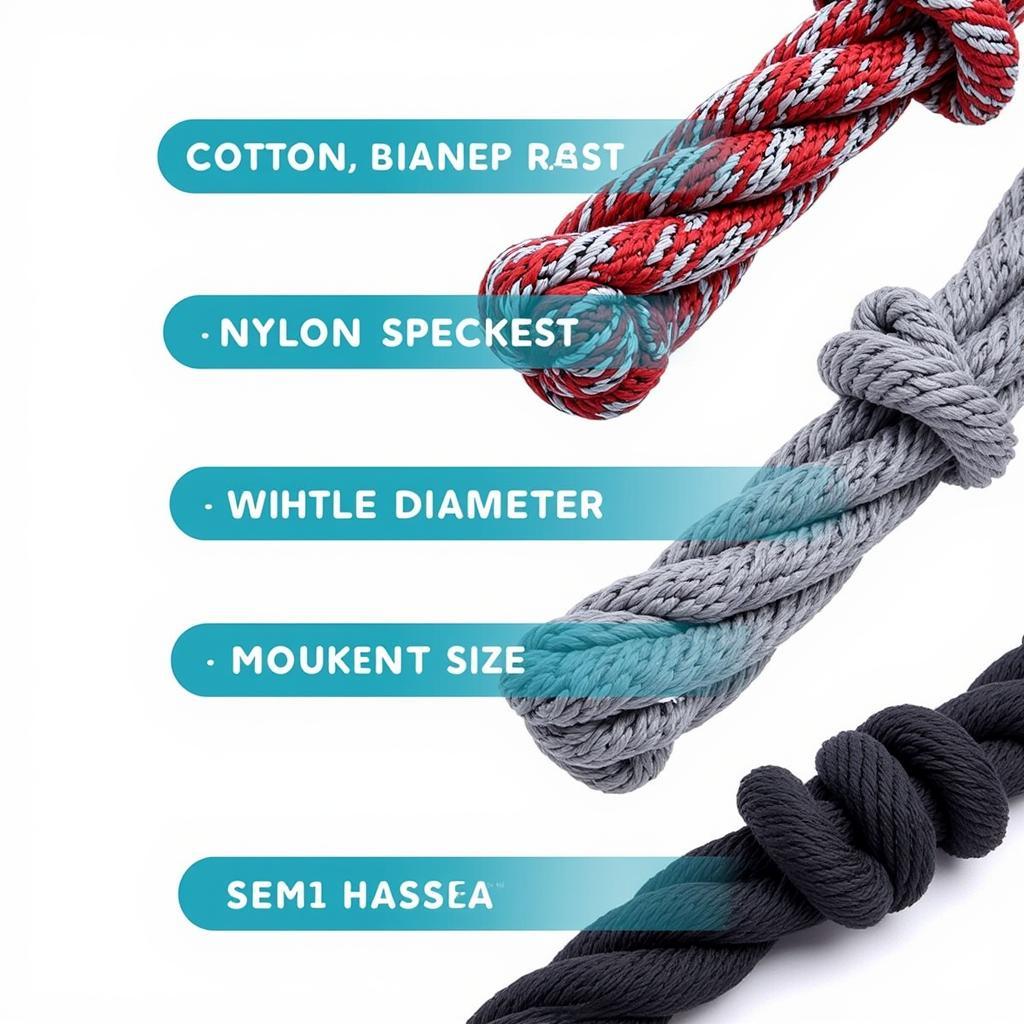A Lunge Rope For Horses is an essential tool in any equestrian’s arsenal. It’s much more than just a long rope; it’s a communication line, a training aid, and a key to unlocking your horse’s athletic potential. Whether you’re a seasoned trainer or a novice horse owner, understanding how to properly use a lunge rope can significantly impact your horse’s well-being and your training success.
Choosing the Right Lunge Rope: Finding the Perfect Fit for Your Equine Partner
Selecting the appropriate lunge rope is crucial for both your safety and your horse’s comfort. Here’s a breakdown of the key factors to consider:
- Material: Lunge ropes are typically made from cotton, nylon, or a blend of both. Cotton ropes are softer and gentler on the hands but may not be as durable. Nylon ropes offer excellent strength and longevity but can be harsher if not handled carefully.
- Diameter: The thickness of the rope impacts its weight and handling. A thicker rope (around 1 inch in diameter) is generally recommended for beginners as it provides a better grip and is less likely to slip through the hands. Experienced handlers might prefer thinner ropes for their lighter weight and increased sensitivity.
- Length: Standard lunge ropes typically range from 25 to 35 feet. The ideal length depends on your horse’s size and the size of the training area. A longer rope allows for a larger circle, while a shorter one offers more control.
 Types of Lunge Ropes
Types of Lunge Ropes
Essential Lunge Rope Techniques: Building a Strong Foundation
Mastering the basic techniques of lunging is paramount before you begin working your horse. Here’s a step-by-step guide to get you started:
- Safety First: Always wear appropriate footwear and gloves to protect yourself. Ensure the lunging area is free from obstacles and distractions.
- Proper Holding: Hold the lunge rope firmly but gently, with a slight drape in the line. Avoid winding the rope around your hand, as this can lead to injury if your horse spooks.
- Body Language: Use clear and consistent body language to communicate with your horse. Your posture, eye contact, and energy will all influence their movements.
- Voice Commands: Incorporate voice commands to reinforce your cues and maintain rhythm during lunging. Use short, distinct words like “walk,” “trot,” and “whoa.”
Benefits of Lunge Work: Unleashing the Power of the Circle
Lunge work offers a myriad of benefits for horses of all ages and disciplines. Here are just a few ways it can enhance your horse’s well-being and performance:
- Improved Fitness: Lunging provides an excellent cardiovascular workout, building muscle and stamina.
- Enhanced Balance and Coordination: The circular movement encourages the horse to engage their core muscles, improving balance and coordination.
- Mental Stimulation: Lunge work provides mental stimulation, helping to prevent boredom and alleviate excess energy.
Troubleshooting Common Lunge Rope Challenges: Overcoming Obstacles on the Circle
Even experienced horse people encounter challenges when lunging. Here are some common issues and solutions:
- Horse Pulling or Rushing: If your horse tends to pull or rush on the lunge line, ensure you are maintaining a consistent pace and using clear, firm cues.
- Horse Falling In or Out: If your horse falls in or out on the circle, adjust your position and use your body language to encourage them to stay on track.
- Horse Lacking Forward Movement: If your horse is reluctant to move forward, use a lunge whip as an extension of your arm to encourage forward momentum.
Beyond the Basics: Exploring Advanced Lunge Rope Exercises
Once you and your horse have mastered the fundamentals of lunging, you can begin to incorporate more advanced exercises.
- Transitions: Practice smooth transitions between gaits, encouraging the horse to maintain balance and rhythm.
- Lateral Work: Introduce lateral movements like leg yields and shoulder-in to further develop your horse’s suppleness and responsiveness.
- Pole Work: Incorporate ground poles into your lunging sessions to encourage your horse to lift their feet and engage their core.
Remember, always introduce new exercises gradually and seek guidance from a qualified trainer if needed.
Conclusion: Embracing the Versatility of the Lunge Rope
The lunge rope is a versatile and indispensable tool for any horse owner. By understanding the nuances of choosing the right rope, mastering essential techniques, and exploring the various benefits of lunging, you can significantly enrich your partnership with your equine companion. From improving fitness to enhancing communication, the lunge rope can open doors to a deeper understanding and a more rewarding relationship with your horse.
Frequently Asked Questions about Lunge Ropes for Horses
Q: How long should a lunging session be?
A: A good starting point is 15-20 minutes, gradually increasing the duration as your horse’s fitness improves.
Q: Can I lunge my horse every day?
A: It’s generally not recommended to lunge your horse every day. Lunging is physically demanding, and rest days are crucial for muscle recovery and injury prevention.
Q: What type of lunge whip is best?
A: A lunge whip with a long lash and a soft cracker is generally recommended.
Q: Can I use a lunge rope to teach my horse to back up?
A: While you can use a lunge rope to encourage your horse to move away from pressure, it’s not the most effective tool for teaching backing. Groundwork exercises specifically designed for teaching backing are more beneficial.
Q: Can I ride my horse in a lunging cavesson?
A: No, you should never ride your horse in a lunging cavesson. Lunging cavessons are designed specifically for groundwork and lack the necessary safety features of a riding bridle.
For more information on horse care and training, explore our other helpful articles:
Have questions about finding the perfect lunge rope for your horse?
Contact us at:
Phone Number: 0772127271
Email: [email protected]
Address: QGM2+WX2, Vị Trung, Vị Thuỷ, Hậu Giang, Việt Nam.
Our dedicated customer support team is available 24/7 to assist you.